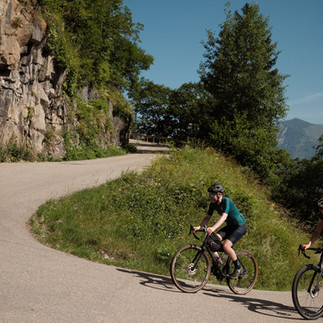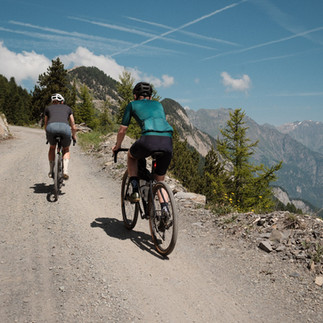Into the Mountains
- Robert Lee

- Jul 16
- 6 min read
Updated: Jul 17
Alpe d’Huez, probably the most famous hill climb in the world—featured in many editions of the Tour de France over the years and on nearly every serious rider’s bucket list.

We left Annecy and the memories of our hellish gravel ride behind in pursuit of more mountains and grander-scale bike rides. As we made our way toward the range, we stopped for lunch en route at one of the many Aires in France. While sorting ourselves out with something to eat, we had a visitor—a woman in her mid-twenties—asking if we were heading to Toulon on the south coast. We weren’t.
Not wanting to leave her hitchhiking from a stop where 99% of people were heading into the Alps, we gave her a lift to Grenoble to maximise her chances of going the right way. We loaded her bags into the back of the van and set off. Her name was Larissa, and she was heading down to see her sister for her birthday. This wasn’t her first time doing so—she hitchhikes semi-regularly. Her current record from Freiburg, Germany to Toulon was under a day. It’s good to see hitchhiking hasn’t completely disappeared.
That afternoon, with great excitement, we found ourselves based just off the foot of the climb in a lovely little campsite in Allemond. Yes, a campsite! We're doing this road trip in our van, but knowing what kinds of rides I had planned for the coming week or two, the lure of instant access to a shower and unlimited water couldn’t be ignored.
We had lovely neighbours from the Netherlands who were happy to have other people to chat to. The owners were also wonderful. We didn’t know it yet, but choosing to base ourselves at this campsite was about to pay dividends.
The next morning, while going about my usual coffee-making routine, I couldn’t help but notice everything felt slightly wonky. I put it down to uneven ground that I hadn’t noticed the day before, but in the back of my mind, I knew I had made sure it was level.
As we were sorting out the bikes and setting up various bits outside the van, Louisa noticed our front driver-side tyre was flat—very flat.

Now, when it comes to bikes and spares, I’m absolutely on it. I carry a concise but capable toolkit everywhere. When it comes to the van… not so much. We’d never had a flat before, and as far as I knew, our spare wheel was under the floor of the garage space—boarded over by the previous owners. Relief came when I spotted the spare mounted underneath the van. Now to get it off.
After some examination on my part, Hans—our Dutch neighbour—came over to help. Someone at Peugeot seriously over-engineered what should be a simple bolt loosening. Instead, it’s a ratchet system with double-action cables that clamp the wheel in place. This absurdly complex mechanism—full of moving parts prone to corrosion—is located right behind the rear driver-side wheel, where all the road grime gets in. Nice one, Peugeot.

When we finally identified the contraption, it should have been simple: loosen a bolt. Instead, something gave way internally, and the wheel remained tightly secured.
Along came Yannick, the campsite owner. He took one look and, in broken English, said, “Two minutes. It’s off,” while making a slicing gesture. I rightly assumed he meant to fetch an angle grinder. Sure enough, within two minutes, we had a spare wheel.
Once the wheel was replaced, Hans’ wife made us all coffee. Honestly, all Louisa and I wanted to do after that was sort the van, eat everything in sight, hide from the sun, and play Backgammon. Huge thanks to Yannick and Hans for their help—and also to the super shonky auto repair shop that plugged our tyre.

Our first adventure the next day was to follow the route of the GFNY cycling event, which had taken place the day our tyre punctured (events coinciding with our visit became a bit of a theme). We downloaded the route and followed it the next day.
The day started off overcast, with low cloud hanging in the mountains—not ideal when most of the day would be spent climbing in anticipation of spectacular views. This came to reality on our first climb up Col de la Morte, where visibility while climbing fluctuated between "can’t see the road" and "can’t see my hands."
At the summit, we prepared for a rather precarious descent. Fortunately, we only lost about 100m of elevation before dropping below the cloud line and were treated to amazing valley views. From there, things only got better. The route included four cols, all on some of the quietest roads we’ve ever ridden in the Alps, culminating in climbing Alpe d’Huez.
By the time we reached the summit of Col d’Ornon, Louisa had had enough climbing for one day. We parted ways at the base of the descent. She headed back to enjoy the sunshine at the campsite, while I set off up Alpe d’Huez in the midday sun—as only an Englishman would.
Twenty-one switchbacks really are something to behold, though the volume of traffic going up and down does take the edge off somewhat. Still, if you follow bike racing of any era, it’s hard not to feel the significance of what’s taken place on that road—cars or not.

After getting lost in Huez village, I finally found the official summit sign and adorned it with a Woods Cyclery sticker. By then, I was ready to return to the van for some respite from the sun, something to eat that wasn’t made by Stykr, and a shower.
Instead of descending the main road, I opted for a quieter descent off the other side of the mountain that delivered me straight into Allemond, where we’d parked.
The rest of our stay followed a similar rhythm. We extended our booking three times—we just kept finding more we wanted to explore. It truly is a paradise for outdoor lovers.
During our stay, we made a new cycling friend, Ben. He had previously been to the area on a bikepacking trip and returned to explore it further. We joined him for one of his rides up to Villard-Notre-Dame, across the gravel at the top, and descending back into Bourg-d’Oisans.
It was honestly one of the best days I’ve ever had on a bike. The scenery was incredible, the riding varied and rewarding, and it was just lovely to have met Ben and share it all.
The next day, we ascended Alpe d’Huez again with Ben—he hadn’t done it yet on this trip. We parted ways at the summit, as he was moving on to his next destination.
Louisa and I carried on, in search of some Alpine gravel. We rode up to Lac Noir—a cool spot, but not quite worth the extra mileage and elevation. There are better routes up toward the ski resorts. We eventually found some beautiful trails that led to what’s known as “the cornice road,” hugging cliffs and winding through stone-bored tunnels, mirroring what we’d ridden the day before.


Unknowingly, we had arrived just as a stage of the Critérium du Dauphiné took place one valley over. The GFNY coincided with our flat tyre, and the Marmotte Gran Fondo was scheduled for the following week.
I nearly entered that one last minute, but the €130 entry fee gave me pause. Louisa even tried to sign me up secretly—only to find out you need a doctor’s note to confirm you’re unlikely to die mid-ride. Sensible, really.
Instead, we rode up the back end of Alpe d’Huez to watch participants climb the final switchbacks. We stationed ourselves at the famed Dutch Corner and watched thousands of cyclists get enthusiastically sprayed by a man with a hose. Some approved. Others… not so much.


Inspired by the route, I decided to tackle it myself a few days later. From our campsite, I headed north toward the Col de la Croix de Fer and down into the next valley. From there, I followed a grimy, industrial stretch toward the base of Col du Télégraphe and then Col du Galibier.
There’s really no accounting for how long these climbs are when combined. But a pleasant surprise emerged: I realised just how much I love taking on big days, self-supported.
The route was about 200km with nearly 5,000m of climbing. When I reached the bottom of Alpe d’Huez—for what was now the fourth time—I thought, “Why?” I wasn’t racing, I had nothing to prove, and I’d already climbed it three times in as many days. I was perfectly content to head back and rest.
That ride made me realise how much I enjoy adventure and endurance cycling—not racing per se. Our trip was partly focused on racing events across Europe, but in truth, I just love riding my bike. Having the fitness, curiosity, willpower, and resilience to ride over any mountain, on any terrain—that’s what it’s about. It’s about the experience and the people you meet along the way.

Spending that time in the mountains opened a door in my mind. I’ve already started letting my imagination run wild with ideas for future adventures and challenges.
Leaving our little campsite was bittersweet. We met wonderful people, went on some of our best rides to date, and bonded with the owners over cutting a spare wheel off our van. But now, we were heading to Germany—for our next race in Singen.
Gallery






























































Comments